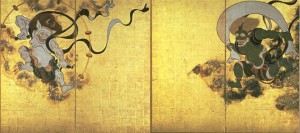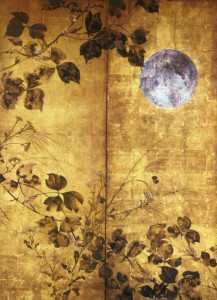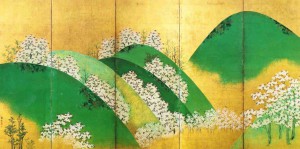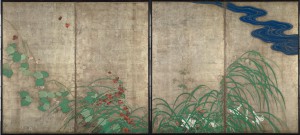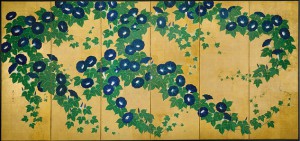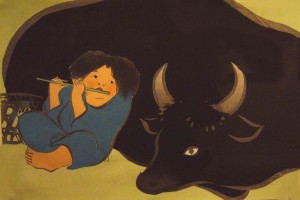Rinpa School / Schools of Nihonga 004
Rinpa School / Summary
A school that flourished in the Edo period. It is characterized by a highly decorative style of painting having clear composition and brilliant colors in which the techniques of the traditional *yamato-e painting are refined.
*Yamato-e painting:
In the latter half of the 9th century, during the Heian period, as court culture became more Japanized, paintings depicting scenery characteristic of Japan began to appear in response to the demand for paintings that express Japanese sentiments. From about the end of the 10 th century, this kind of painting, inheriting the style of the Heian period, began to be called yamato-e, to distinguish it from the Chinese painting/Chinese-style painting (later known as kanga), or paintings with Chinese themes that were influenced by Song and Yuan painting styles. The style of the yamafo-e painting was transmitted through edokoro (official bureau of painting) which had been in charge of court paintings since the Heian period. When the Tosa family inherited the administration of the edokoro (the courtly office for paintings) in the Muromachi period, the word yamato-e began to be used to refer not only to themes and style, but also to the concepts of the Tosa School.
Houitsu Sakai (1761-1829), holding great esteem for and inheriting the painting style of Kourin Ogata (1685-1716), established the Edo Rinpa Scool, thus leading to the formation of today’s concept concerning Rinpa School. Since Kourin admired Soutatsu Tawaraya (achieve c. 1602-31), the origin of Rinpa School may be traced back to the time of Soutatsu and the name Soutatsu-Kourin School is also used.
Rinpa School was not inherited by blood but was developed by artists who, by their own will, chose their masters, surpassing time. Pupils of other schools in the Edo period such as the Kanou school and the Maruyama school learned painting technique directly from their teachers by copying their works. The Rinpa style, on the other hand, was inherited by people of various social standings living in different times and locations, which is a unique characteristic of this school. While the Rinpa school maintained its identity by deliberately choosing and following similar subjects, design and unique technique, artists added their own discoveries and interpretations to augment the existing style.
Rinpa School has close connections with various fields of crafts such as ceramics, maki-e (urushi lacquer work decorated with sprinkled metal powder) and textiles. It is believed that major artists managed their studios where they produced their works.
Name
In the past, Kourin Ogata, Kenzan Ogata and Houitsu Sakai who took over their style were regarded as a school, being referred to as the “Kourin school,” whereas, the Kourin school, in addition to the artists such as Soutatsu Tawaraya and Kouetsu Honami, who were considered to be the predecessors of that school, were collectively known as the “Soutatsu-Kourin school.” Today, it is more commonly referred to as the “Rinpa school.”
Characteristics
The characteristics of the Rinpa school include the use of gold and silver leaves in the background, daring picture compositions, repetitions of stencil patterns and Tarashikomi technique (a technique that achieves shading through pooling successive layers of partially dried pigment). The subjects were predominantly flowering trees/shrubs and flowers, but there were some works including narrative pictures depicting people, birds and animals, landscapes and nature as well as a few Buddhist paintings.
Influence
The Rinpa school has had a major impact on the Impressionist school in Europe as well as contemporary Japanese-style painting and design. Fuujin Raijin zu (the Wind and Thunder Gods) has been painted by numerous artists that have often been compared against one another. At the “RIMPA” Exhibit held at the National Museum of Modern Art, Tokyo in 2004, it was said that the “Rinpa influence” was detected in the works of Gustav Klimt and Andy Warhol in addition to some Japanese-style paintings (by various artists including Shunso Hishida and Taikan Yokoyama) after the Meiji period.
Famous Artists
Kouetsu Honami (1558-1637)
Soutatsu Tawaraya (The early Edo period)
Sousetsu Tawaraya (The early Edo period)
Sousetsu Kitagawa (The early Edo period)
Kourin Ogata (1658-1716)
Kenzan Ogata (1663-1743)
Shikou Watanabe (1683-1755)
Roshuu Fukae (1699-1757)
Houchuu Nakamura (?-1819)
Houitsu Sakai (1761-1828)
Kiitsu Suzuki (1796-1858)
Koson Ikeda (1801-1866)
Hou Sakai (1808-1841)
Kiei Murakoshi (1808-1867)
Kouitsu Yamamoto (1843? – 1905?)
Gekkou Ogata (1859-1920)
Sekka Kamisaka (1866-1942)
Famous Artworks

